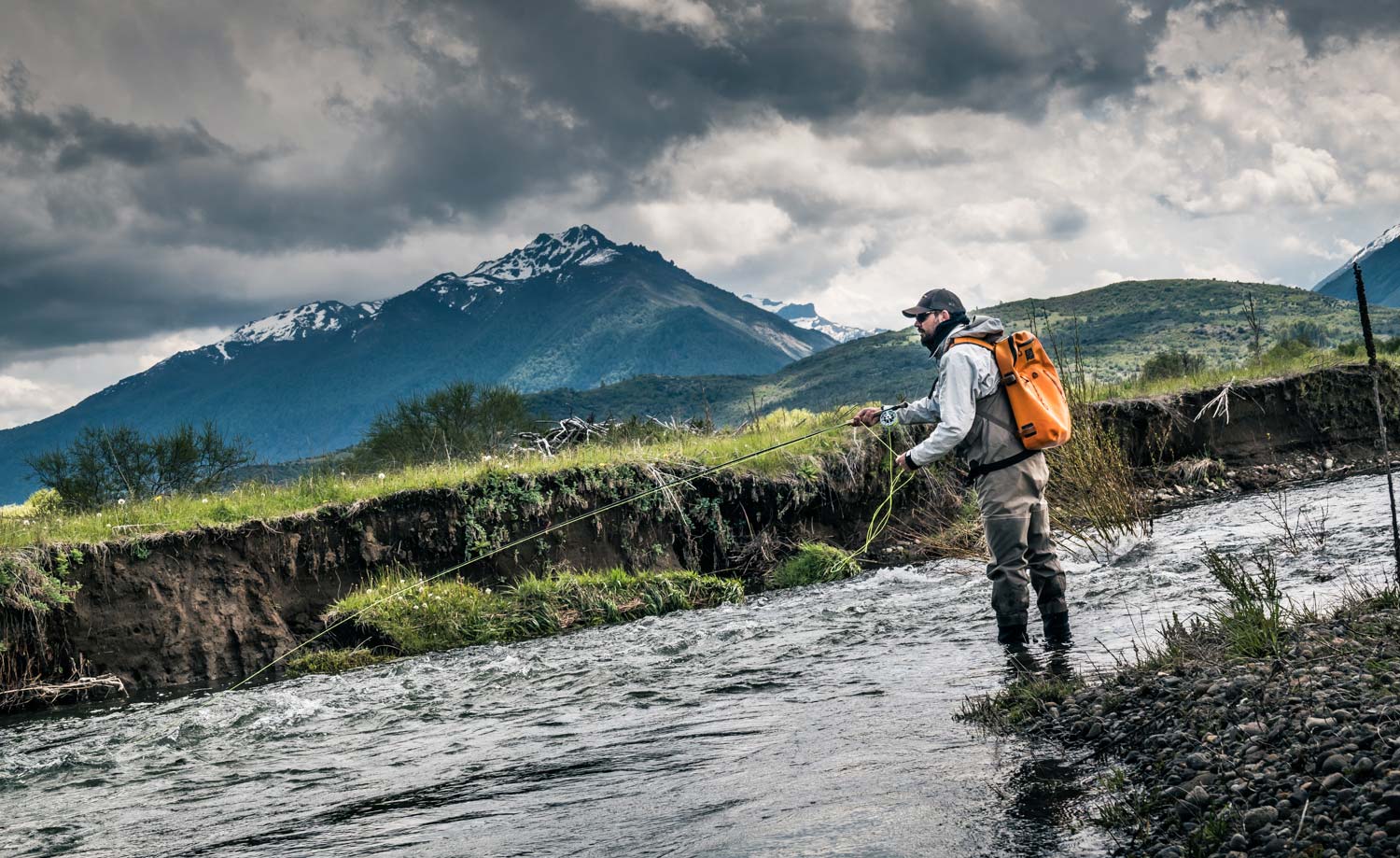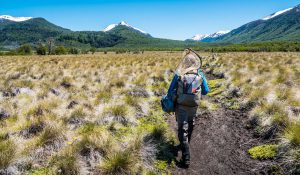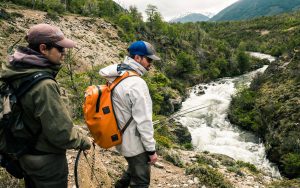
Photos by Louis Cahill
By Louis Cahill
Every angler knows that the further you walk, the better the fishing.
Keep that in mind when I tell you, I recently had some of the best trout fishing of my life in the Andes mountains of Patagonia. That should give you some idea how much we walked. The rewards where big. The rivers we fished were pristine and without a trace of humans, the views and wildlife were stellar and the trout were big and plentiful. That’s worth the walk seven days a week.
I did have to spend some time thinking through my gear and necessities for the trip. Hike in fishing requires a little more preparation, even when you are just day-hiking. Simple stuff you might run back to the truck for can turn into a big deal miles up the trail. Most of this is common sense but I will try to be thorough for the uninitiated.
Here are 12 tips for a day of hike-in fly-fishing.
Boots, Wading vs. Hiking
 I’ve broken both my feet several times. Good boots are important to me. I want something that gets good traction, gives me good arch support and good ankle support. Most wading boots make poor hiking boots so, given the choice, I’ll hike in hiking boots and change to wading boots. Sometimes the hiking takes you through the river and then, wading boots are the ticket. It helps to know the trail you’ll be taking.
I’ve broken both my feet several times. Good boots are important to me. I want something that gets good traction, gives me good arch support and good ankle support. Most wading boots make poor hiking boots so, given the choice, I’ll hike in hiking boots and change to wading boots. Sometimes the hiking takes you through the river and then, wading boots are the ticket. It helps to know the trail you’ll be taking.
Whether I’m hiking in them or not, my first choice is the Simms Intruder boots. They are actually pretty good for hiking and they are very lightweight, which is nice if you’re carrying them. A good trick is to carry a plastic bag and stash your hiking boots somewhere out of sight and safe from rain in their bag, while you’re fishing.
Camping towel and dry socks
If you are changing boots, a lightweight camp towel and a fresh pair of dry socks are really nice to have. Even if you are fishing in waders you can end up with wet socks that might cause blisters.
Day pack
A good waterproof backpack is a must have. I use the Fishpond roll top, but the new model with the T-Zip is a nice upgrade. In addition to keeping your gear dry and together, I have used these packs as flotation devices for sketchy river crossings.
Extra pockets
Pockets for frequently used gear let me fish from my backpack, without carrying a fishing pack too. It’s a good idea to pair down your gear to just the essentials. Extra gear is just extra weight to carry. The hiker’s saying, “Ounces make pounds and pounds make pain,” is true.
 Rod in the sock
Rod in the sock
It’s a pain hiking with your rod put together and a tube is just extra weight. A rod sock is usually all you need to keep your rod safe. If I feel like I’m going to need more protection, I have a couple of carbon fiber rod tubes I’ll use for their light weight.
Filter bottle
A good filter bottle is absolutely necessary. Hydration is super important, but carrying water is crazy. Carry an empty bottle and drink from the river. The Katadyn Be Free is the best I’ve used. It weighs nothing and fits in a pocket.
TP
When nature calls, it’s good to have an answer. Enough said.
Walking stick
A good walking stick is an awesome tool. A third point of contact can keep you from turning an ankle on rough ground, and doubles as a wading staff fir tough crossings. Luckily, they grow on trees. Cut one on the trail and toss it when you don’t need it.
Basic survival
Bad stuff can happen. It’s just smart to be prepared. I have learned the hard way that there are a few things worth carrying in the backcountry. A Space Blanket, knife and lighter can get you through some tough scrapes.
If you’re interested in what to do when things go wrong, read “Surviving the worst in cold weather”
 Simple first aid
Simple first aid
Hopefully a blister is the worst thing you’ll have to deal with, but if not, be prepared. Some good medical tape can be a lifesaver. Tape works great for stopping serious bleeding or for fashioning a splint. A little super glue makes a great field dressing too. It’s not a lot to carry but it can sure come in handy.
GPS
The first time I seriously hurt myself on a hike in trip, I didn’t have a GPS. It was the middle of winter and I didn’t make it back to the truck until after 10:00 PM. I was sure there was a shorter way out but I wasn’t confident i could find it. I bought a GPS immediately.
Let someone know before you go
Maybe the most important thing you can do is let someone know where you’re going and when to expect you back. Especially in the colder months. Watch “127 Hours” if you don’t think I’m right.
I hope this helps on your next hike in fishing trip. If you have other tips, or a story to share, let us know in the comments.
Louis Cahill Gink & Gasoline www.ginkandgasoline.com hookups@ginkandgasoline.com Sign Up For Our Weekly Newsletter!
YES!
All lone anglers, hikers, hunters should be required watch 127 Hours or read, Between A Rock and A Hard Place. Rolston’s experience will forever change your habits. It would have taken him 12.7 seconds to write a note, Instead it took 127 hours and the loss of a hand before he was rescued.
Best option for GPS is Gaia app for phones. Pre-visit the area online and download your own custom map/s to your phone with preselected waypoints. When you get out there and have no service on your phone you still have GPS, your phone, and the working map, with waypoints, and your phone in airplane mode. Accurate. Awesome.
Best water filter by far for use and least weight is HydroBlue. Way lighter than Katadyn or anything you’d find in a backpacking store.
Carry an empty disposable water/coke/juice bottle, with @ 2′ of duct tape wrapped around it. Weighs a fraction of any other water bottle, Threads mate to the threads on the HydroBlue filter, and the duct tape is for emergency repairs of you or equipment.
nice review! I frequently hike and fish for a full day, and have found another Fishpond product that is really nice. it features a full backpack, with a hook ring, and a traditional fly fishing vest on the front, i.e. all those pockets.
Pingback: Tippets: Traditional Tenkara Flies, Prep for Hike-In Trips | MidCurrent